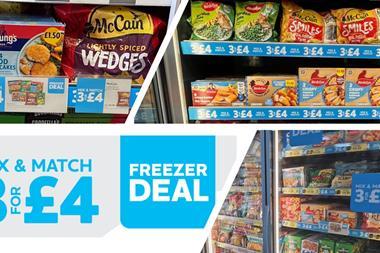Cheese shows a huge potential for growth if customers look beyond the block.
When you think of the value items in your store, you’ll probably list alcohol, tobacco and stalwarts such as milk and bread. Few would think of cheese and yet this market outstrips many sectors in value.
While the total bread market stands at £1.30bn in value, cheese weighs in at £1.84bn and a 4% growth year on year (The Cheese Report 2005, Dairy Crest). And if consumption could be pushed up to European levels, profits would be enormous. We consume about 30g of cheese a day compared with 50g in Europe (Mintel).
Says Dairy Crest Foods marketing director Richard Tolley: “Because the market is so large any growth is significant - even in a market half the size, 2-3% growth is useful.”
According to Mintel, volume of cheese has grown in the UK by 11% between 2000 and 2004 to 358 tonnes, but value has outstripped volume due to price increases and trading up to premium Cheddars, convenience formats and speciality cheeses. Mintel estimates the market will reach £1.89bn in 2005.
Customers also want brands, which have shown a phenomenal growth and now boast a 60% share of the marketplace. Cheddar dominates with 53%
of the market (The Cheese Report) but consumers are looking beyond block cheese to convenience formats, especially grated cheese. The convenience sector grew at 17% between 2002 and 2004 with sliced accounting for two-thirds of sales (Mintel). And Cheddar has been given a boost by consumers moving to stronger flavours.
Fresh from travels around the globe and emboldened by ideas from celebrity chefs, shoppers are keen to try something new. As a result Continental cheese has grown 25% in the period 2000-2004 and accounts for 20% of the market. Processed cheese has grown by 23% over the same period, driven by snack products which are targeted at kids (Mintel).
This taste for adventure is also being reflected in a growth in sales of cheese blended with other food - such as Wensleydale with cranberries. Says Ilchester Cheese business development manager Alan Honan: “There’s a lot more demand for additions in cheese as people become more adventurous.”
RECIPE CARD
To drive the category further, cheese manufacturers agree that the number of ways in which cheese can be used must be promoted. According to The Cheese Report, there were 5.6 billion meal occasions featuring cheese in 2004 but a whopping 43% of all cheese is consumed in sandwiches.
“The UK consumer has a range of about three to 10 standard meals. Cheese appears on average in 25% of meal occasions. This is the key to unlocking potential,” says Tolley. Galbani marketing manager Stephanie Shakibai agrees this is a major opportunity for c-stores. “Some smaller shops have a limited choice and there is space for a wider range of products. If people are on their way home from work they want to prepare something nice.”
Honan says that the growing trend for smaller portion sizes, taken from supermarket delis, could help drive growth: “We’re beginning to see prepacked smaller portions which cater for one or two people - this will increase.” He adds that the trend for adult snacks will also become more evident. “The challenge for cheese companies is to hit the right taste profile in the right size.”
What’s what in the cheese sector
The Cheese Report from Dairy Crest splits the cheese category into several sectors: kids, adult snacks, everyday family, taste & discovery, better for you and meal solutions. Each category is split into several subcategories.
Within this sectors the areas to look out for include:
Kids: value £167m. While lunchbox and meals both show decline, the snacks sector shows a 12% growth year on year helped by innovation such as cheese strings.
Adult snacks: value £19m. Showing growth in its three subcategories of sharing (+4%) snacks (+27%) and lunchbox (+282%).
Everyday family: value £838m. Growth in everyday special (+2%) and everyday value (+3%).
Taste & discovery: value £396m. Growth in flavoured (+7%), goats’ (+23%), soft (+10%), rubbery (+13%) and specific including premium farmhouse Cheddars, Australian, Canadian, vintage Cheddars) (+6%).
Better For You: value £240m. Growth in low fat (+11%). Spreads and cottage both showing decline.
Meal Solutions: value £165m. Growth in convenience +14% and recipe ingredients such as mozzarella and
feta (+2%).
When you think of the value items in your store, you’ll probably list alcohol, tobacco and stalwarts such as milk and bread. Few would think of cheese and yet this market outstrips many sectors in value.
While the total bread market stands at £1.30bn in value, cheese weighs in at £1.84bn and a 4% growth year on year (The Cheese Report 2005, Dairy Crest). And if consumption could be pushed up to European levels, profits would be enormous. We consume about 30g of cheese a day compared with 50g in Europe (Mintel).
Says Dairy Crest Foods marketing director Richard Tolley: “Because the market is so large any growth is significant - even in a market half the size, 2-3% growth is useful.”
According to Mintel, volume of cheese has grown in the UK by 11% between 2000 and 2004 to 358 tonnes, but value has outstripped volume due to price increases and trading up to premium Cheddars, convenience formats and speciality cheeses. Mintel estimates the market will reach £1.89bn in 2005.
Customers also want brands, which have shown a phenomenal growth and now boast a 60% share of the marketplace. Cheddar dominates with 53%
of the market (The Cheese Report) but consumers are looking beyond block cheese to convenience formats, especially grated cheese. The convenience sector grew at 17% between 2002 and 2004 with sliced accounting for two-thirds of sales (Mintel). And Cheddar has been given a boost by consumers moving to stronger flavours.
Fresh from travels around the globe and emboldened by ideas from celebrity chefs, shoppers are keen to try something new. As a result Continental cheese has grown 25% in the period 2000-2004 and accounts for 20% of the market. Processed cheese has grown by 23% over the same period, driven by snack products which are targeted at kids (Mintel).
This taste for adventure is also being reflected in a growth in sales of cheese blended with other food - such as Wensleydale with cranberries. Says Ilchester Cheese business development manager Alan Honan: “There’s a lot more demand for additions in cheese as people become more adventurous.”
RECIPE CARD
To drive the category further, cheese manufacturers agree that the number of ways in which cheese can be used must be promoted. According to The Cheese Report, there were 5.6 billion meal occasions featuring cheese in 2004 but a whopping 43% of all cheese is consumed in sandwiches.
“The UK consumer has a range of about three to 10 standard meals. Cheese appears on average in 25% of meal occasions. This is the key to unlocking potential,” says Tolley. Galbani marketing manager Stephanie Shakibai agrees this is a major opportunity for c-stores. “Some smaller shops have a limited choice and there is space for a wider range of products. If people are on their way home from work they want to prepare something nice.”
Honan says that the growing trend for smaller portion sizes, taken from supermarket delis, could help drive growth: “We’re beginning to see prepacked smaller portions which cater for one or two people - this will increase.” He adds that the trend for adult snacks will also become more evident. “The challenge for cheese companies is to hit the right taste profile in the right size.”
What’s what in the cheese sector
The Cheese Report from Dairy Crest splits the cheese category into several sectors: kids, adult snacks, everyday family, taste & discovery, better for you and meal solutions. Each category is split into several subcategories.
Within this sectors the areas to look out for include:
Kids: value £167m. While lunchbox and meals both show decline, the snacks sector shows a 12% growth year on year helped by innovation such as cheese strings.
Adult snacks: value £19m. Showing growth in its three subcategories of sharing (+4%) snacks (+27%) and lunchbox (+282%).
Everyday family: value £838m. Growth in everyday special (+2%) and everyday value (+3%).
Taste & discovery: value £396m. Growth in flavoured (+7%), goats’ (+23%), soft (+10%), rubbery (+13%) and specific including premium farmhouse Cheddars, Australian, Canadian, vintage Cheddars) (+6%).
Better For You: value £240m. Growth in low fat (+11%). Spreads and cottage both showing decline.
Meal Solutions: value £165m. Growth in convenience +14% and recipe ingredients such as mozzarella and
feta (+2%).

























No comments yet